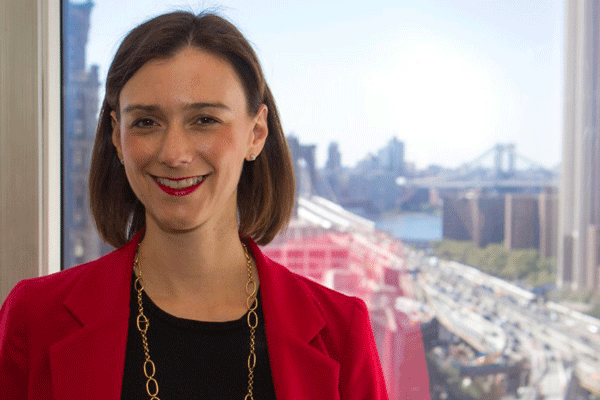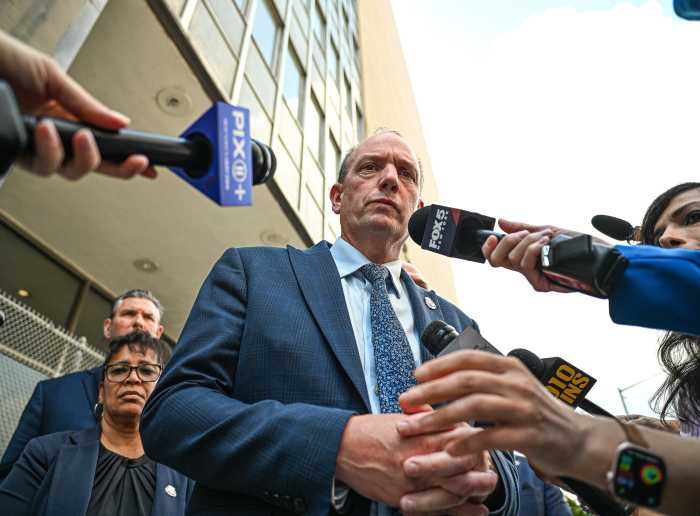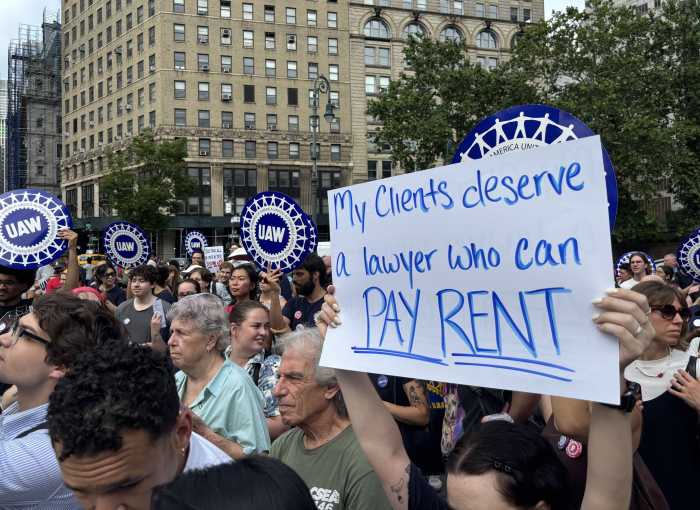BY SCOTT STIFFLER | Citing experience and perspective gained during nearly eight years in elected office — and addressing matters including the ULURP process, community board reform and term limits — District 5 City Councilmember Jessica Lappin (Democrat) met with NYC Community Media on July 10, to outline her agenda if elected to the position of Manhattan Borough President.
The newspaper group — comprised of Chelsea Now, The Villager, The East Villager, Downtown Express and Gay City News — is in the process of speaking with candidates for mayor, borough president and the District 3 city council seat currently held by Speaker Christine Quinn. Our endorsements will be announced several weeks before the September 10 primary, and may not necessarily be consistent across all publications.
Along with publisher Jennifer Goodstein, our editors will be asking candidates to detail their position on issues of concern to the general electorate as well as each paper’s specific readership. In addition to this ongoing series of dialogues, NYC Community Media is sponsoring or co-sponsoring several public forums and debates — among them, an August 7 Manhattan Borough President debate (in partnership with Citizens Union and NYU).
COMMUNITY NEEDS SAVVY ORGANIZING, RESOURCES TO NAVIGAGTE ULURP PROCESS
Regarding local dissatisfaction with the vetting period that ultimately allowed Jamestown Properties to vertically expand Chelsea Market, Lappin was asked what, if any, changes she’d bring to the Uniform Land Use Review Procedure (ULURP) process. Lappin noted that although “At the end of the day, a developer has to have an economically feasible project,” negotiation for alterations in project size as well as benefits to the surrounding community is “a process. I would like to think that each developer comes in willing to make concessions.”
Adding that she would like to see applicants “commit upfront, early on, to as much as they can,” Lappin also asserted that, “The borough president should play a central role” in shepherding ULURP applications while they’re at the community board level, before it reaches the BP’s desk. “Whatever it is they need to be heard through the process, I think the borough president should be helping make sure that happens — and that’s something that I don’t think [current borough president] Scott [Stringer] has done as much as I would do.” Lappin specified that as BP, she’d make sure “that a community has the resources. I don’t just mean money, but also the expertise, the support and the access to professionals such as architects — even help with putting a PowerPoint presentation together.”
Recalling her work on the two million-square-foot Cornell/Technion project, Lappin cited the formation of the Roosevelt Island Community Coalition as a way to ensure that “there is a coalition of people who are actively engaged.” Armed with a list of design and use scenarios detailed in a seven-page document produced by the coalition, Lappin “worked with Cornell to make sure that it wasn’t sort of an eleventh-hour, here are the things we’re giving you. Because I do think it’s helpful for people to really know what’s being discussed…so that by the time it’s at the community board, there is a coalition of people who are actively engaged.”
TECH UPGRADES AND TERM LIMITS?
Lappin would also use her position as borough president to facilitate better city planning at the community board level. “The land use process is so reactive by definition,” she observes, “and if we’re not doing the proactive planning that we need, and identifying those needs community board by community board, then we’re not always taking advantage of the opportunities that come up through a rezoning.” The establishment of a Community Stat database analogous to that used by the City Council would (according to a campaign policy paper) “enable district managers to log, track and map license and land use applications across the district.”
Other technology upgrades would include online surveys, crowd-sourcing maps and the live streaming of monthly full board meetings. Lappin also envisions “a more business-friendly model” which would make the application process for liquor licenses and sidewalk cafes uniform from board to board, allowing bar or restaurant owners to expand to locations in other board jurisdictions without having to navigate unfamiliar rules and regulations. Lappin would accelerate the creation of new businesses by establishing “a regulatory review panel, within the borough president’s office, and take a look at some of the outdated regulations. I would also have an in-house expediter to help businesses deal with different agencies.”
Lappin is also calling for term length adjustments and consecutive term limits for community board committee chairs. Length currently varies from one to two years, with term limits anywhere from two (as is the case with CB4) to four (CB5) to none (CB3).
Invoking details from her campaign’s policy paper (“Recommendations for Retooling and Reform”), Lappin noted that although she’s not advocating a specific time frame for limits (“I would want to have that discussion with the boards”), she does want to facilitate an atmosphere that serves the fact that community board committees are “supposed to be forums for the public to be heard, and to be part of civic life in the city. And that’s hard when you have these factions develop.” Committee chairs, she points out, “are elected by their boards and not the public. Rotating leadership would help depoliticize boards,” promote fairness and broaden community participation. “You know, I think they’ve gotten too political,” she says, noting that in addition to limits for chairs, “I don’t think you should appointed to the board for life.”
Lappin also favors term limits for the police commissioner. “Twelve years,” she said, referring to Ray Kelly’s tenure, “is long enough for somebody to run a powerful agency like the New York Police Department…I think it’s time for us to have some new leadership.”
Although community boards — like the BP — wield largely advisory powers, Lappin vowed to be more aggressive in using her ability to introduce legislation and increase the viability of Manhattan to attract and retain the middle class. In addition to the preservation and creation of affordable housing, Lappin would “establish a middle school task force on day one.”
Further subject matter covered during Lappin’s July 10 meeting with NYC Community Media will be featured in future issues of Chelsea Now, alongside policies, goals and strategies articulated by other candidates we’ll be meeting with in the coming weeks (including mayoral candidate Christine Quinn and city council candidate Corey Johnson).





































